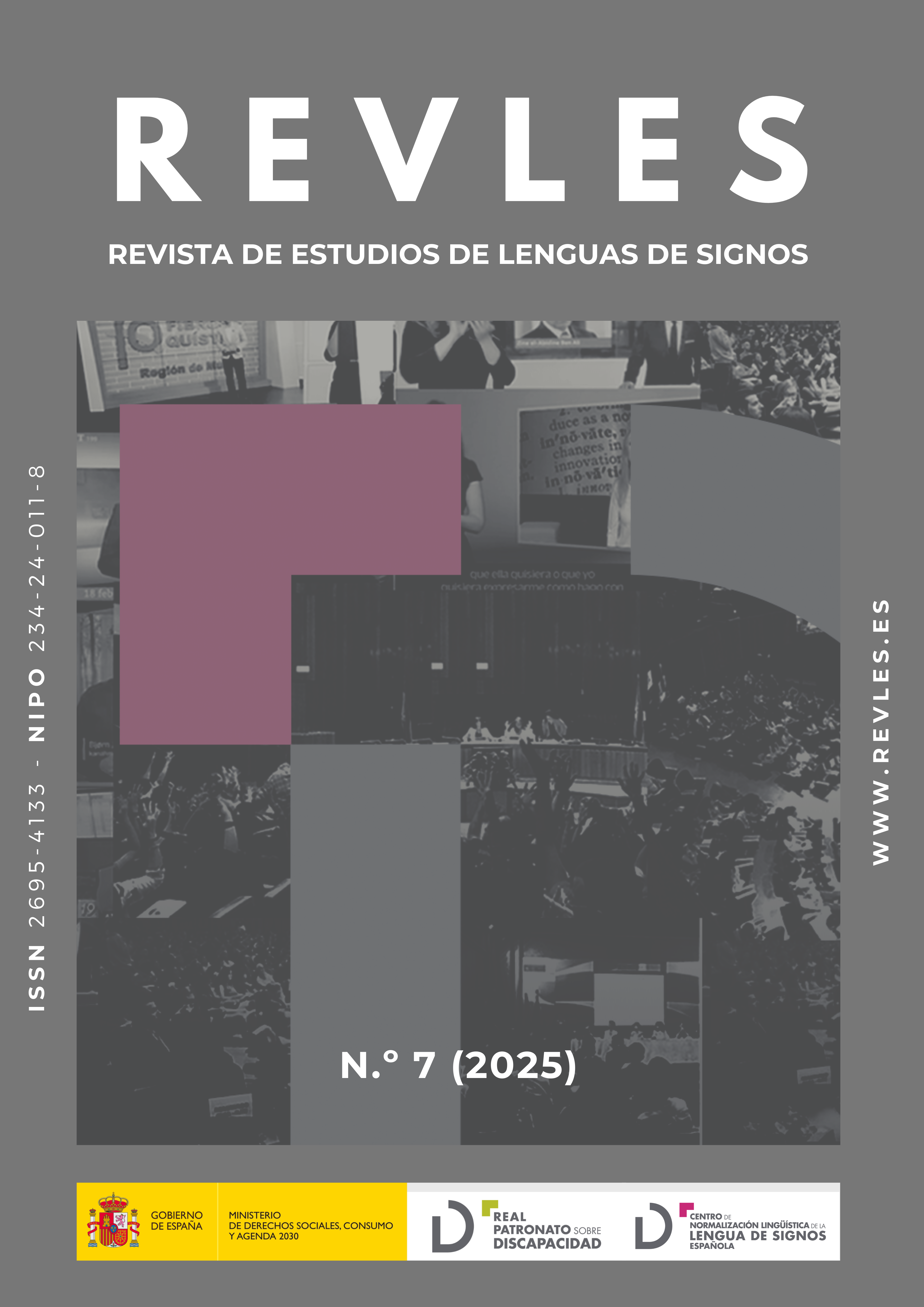Abstract
Morales López's (2024) work, "Linguistic Deprivation in Deaf and Deafblind Childhood and Adolescence," constitutes an essential contribution to the vindication and understanding of the linguistic rights of deaf and deafblind people. In this work, the author addresses the need to establish, from an early age, a model of intermodal bilingualism in the education of the community, in sign and oral languages, to avoid the consequences for the development of any individual of not adequately acquiring a natural language in the first years of life. For the first time in our country, the phenomenon of linguistic deprivation is explicitly analyzed, and the results of an education traditionally based on an oralist methodology, which prioritizes the hearing rehabilitation of the deaf and deafblind population through the use of prostheses such as cochlear implants, are questioned from a linguistic, psycholinguistic, and neurolinguistic perspective. Despite technological advances and current legislation, in this publication, Morales López denounces with academic rigor the violation of fundamental rights observed in this group through the various cases of deprivation or semi-lingualism he has documented to date. The testimonies and examples he provides throughout the text also demonstrate the limitations that the healthcare and education systems still impose on families when it comes to providing them with the means and resources necessary to promote, as soon as possible, the learning and use of a sign language as a first language, ensuring the comprehensive development of their deaf or deafblind children. The interdisciplinary and informative nature of the work makes it a reference reading for families, professionals, and students involved in the fields of healthcare and education.
References
Consejo de Europa (2020). Marco común europeo de referencia para las lenguas: aprendizaje, enseñanza, evaluación: Volumen complementario. Consejo de Europa. https://cvc.cervantes.es/ensenanza/biblioteca_ele/marco_complementario/mcer_volumen-complementario.pdf
Emmorey, K., Giezen, M. R., y Gollan, T. H. (2016). Psycholinguistic, cognitive, and neural implications of bimodal bilingualism. Bilingualism: Language and Cognition, 19(2), 223-242. doi.org/10.1017/S1366728915000085
Glickman, N. S. (2007). Do you hear voices? Problems in assessment of mental status in deaf persons with severe language deprivation. The Journal of Deaf Studies and Deaf Education, 12(2), 127–147. https://doi.org/10.1093/deafed/enm001
Glickman, N. S. (Ed.). (2013). Deaf mental health care. Routledge.
Gómez Monterde, L. y Bao-Fente, M.C. (2024). Informe sobre la educación bilingüe en lengua de signos y lengua oral del alumnado sordo: condiciones básicas. Real Patronato sobre Discapacidad-Centro de Normalización Lingüística de la Lengua de Signos Española. https://cnlse.es/es/recursos/publicaciones/informe_educacion_bilingue_alumnado_sordo.pdf
Grosjean, F. (2000). El derecho del niño sordo a crecer bilingüe. El bilingüismo de los sordos, 1(4), 15-18.
Gulati, S. (2019). Language deprivation syndrome. En N. S. Glickman y W. C. Hall (eds.), Language deprivation and deaf mental health (pp. 24-53). Routledge.
Hall, M. L. (2020). Dissociating the impact of auditory access and language access in Deaf children’s cognitive development. En M. Marschark y H. Knoors (eds.), The Oxford handbook of Deaf studies in learning and cognition (pp. 99-122). Oxford University.
Humphries, T., Kushalnagar, P., Mathur, G., Napoli, D. J., Padden, C., y Rathmann, C. (2014). Ensuring language acquisition for deaf children: What linguists can do. Language, 90(2), e31-e52. https://dx.doi.org/10.1353/lan.2014.0036
Ley 27/2007, de 23 de octubre, por la que se reconocen las lenguas de signos españolas y se regulan los medios de apoyo a la comunicación oral de las personas sordas, con discapacidad auditiva y sordociegas. Boletín Oficial del Estado, núm. 255 de 24 de octubre de 2007. https://www.boe.es/eli/es/l/2007/10/23/27/con
Marchesi, A. (1987). El desarrollo cognitivo y lingüístico de los niños sordos: perspectivas educativas. Alianza.
Mineiro, A., Nunes, M. V. S., Moita, M., Silva, S., y Castro-Caldas, A. (2014). Bilingualism and bimodal bilingualism in deaf people: a neurolinguistic approach. In M. Marschark, G. Tang y H. Knoors (Eds.), Bilingualism and bilingual deaf education (pp. 189-210). Oxford University. https://doi.org/10.1093/acprof:oso/9780199371815.003.0008
Naciones Unidas (2006). Convención sobre los Derechos de las Personas con Discapacidad. Naciones Unidas. https://www.un.org/esa/socdev/enable/documents/tccconvs.pdf [Instrumento de Ratificación de la Convención sobre los derechos de las personas con discapacidad, hecho en Nueva York el 13 de diciembre de 2006. Boletín Oficial del Estado, núm. 96, de 21 de abril de 2008. https://www.boe.es/eli/es/ai/2006/12/13/(1)].
Plaza-Pust, C. (2016). Sign bilingualism in education: Challenges and perspectives along the research, policy, practice axis. Ishara.
Pérez Martín, M., de la Fuente, B., Alonso, P., y Echeita, G. (2019). Four co-enrollment programs in Madrid: Differences and similarities. En M. Marschark, S. Antia y H. Knoors (Eds.), Co-enrollment in Deaf education (pp. 235–256). Oxford University.
Pérez Martín, M., Valmaseda Balanzategui, M., y Morgan, G. (2014). Sign bilingual co-enrollment education for children with cochlear implants in Madrid, Spain. En M. Marschark, G. Tang y H. Knoors (Eds.), Bilingualism and bilingual Deaf education (pp. 368–395). Oxford University.
Pontecorvo, E., Higgins, M., Mora, J., Lieberman, A. M., Pyers, J. y Caselli, N. K. (2023). Learning a sign language does not hinder acquisition of a spoken language. Journal of Speech, Language, and Hearing Research, 66(4), 1291-1308. https://doi.org/10.1044/2022_JSLHR-22-00505
Porteiro Fresco, M. y Báez Montero, I. C. (2025). Translenguaje multimodal. Estudios De Lingüística Aplicada, 80, 127-149. https://doi.org/10.22201/enallt.01852647p.2025.80.1099
Sacks, O. (1991). Veo una voz: Viaje al mundo de los sordos. Anaya y Mario Muchnik.
Real Decreto 674/2023, de 18 de julio, por el que se aprueba el Reglamento de las condiciones de utilización de la lengua de signos española y de los medios de apoyo a la comunicación oral para las personas sordas, con discapacidad auditiva y sordociegas. Boletín Oficial del Estado, núm. 17 de 19 de octubre de 2023. https://www.boe.es/eli/es/rd/2023/07/18/674

This work is licensed under a Creative Commons Attribution-NoDerivatives 4.0 International License.
Copyright (c) 2025 María C. Bao-Fente

